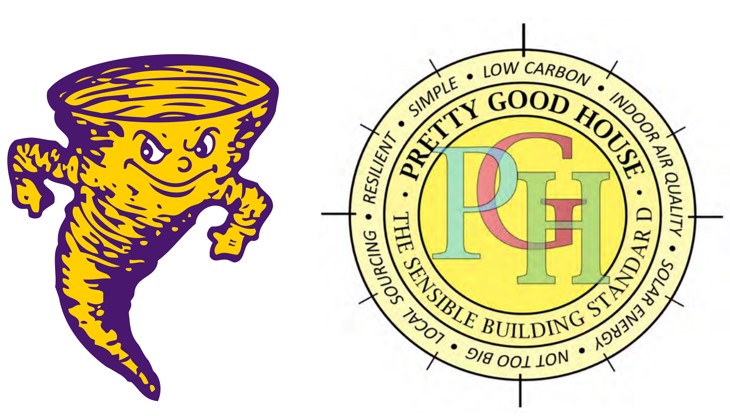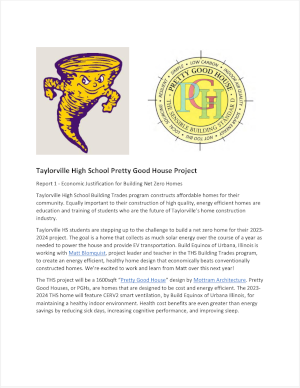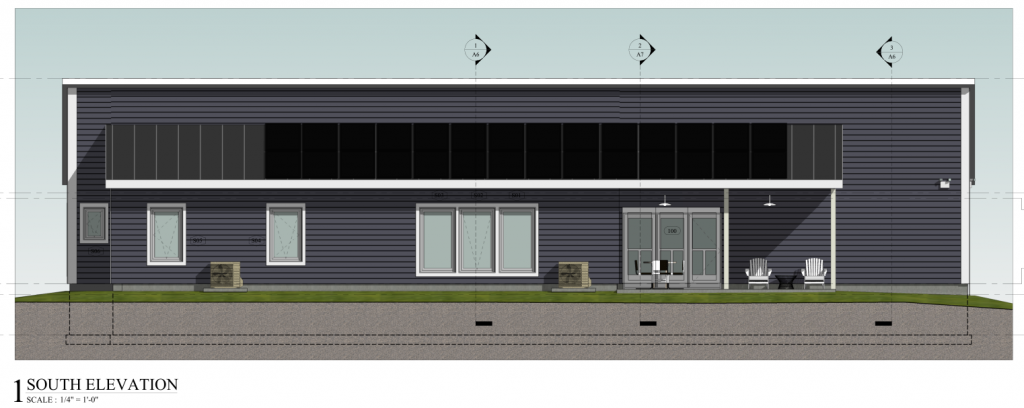
Build Equinox is excited to partner with teacher Matt Blomquist and Taylorville High School’s building trades program as they begin construction on their newest home construction project; a net zero “Pretty Good House” designed by architect Emily Mottram, a co-author of Pretty Good House; A Guide to Creating Better Homes.
Matt Blomquist teaches building trades at Taylorville high school, a community southeast of Springfield Illinois. Matt’s excellence as a teacher is recognized in his school district and beyond as Harbor Freight’s 2022 prize for teaching excellence. In addition to teaching his students, Matt regularly teaches teachers who are eager to develop programs like Taylorville High School’s building trades program.
The aptly named Taylorville Tornadoes are unfortunately too familiar with one of Nature’s most destructive forces. A 2018 storm injured several citizens while damaging and destroying 500 buildings in Taylorville. Another storm passed through Taylorville this summer with less damage, but a reminder of Nature’s ability to disrupt and destroy a community in minutes. Taylorville continues to rebuild itself from the 2018 storm, and Matt and his students are an important part of the rebuilding process.
Equally important to the homes that Matt and students are building is the development of skilled workers for their community’s home building industry. Taylorville’s 10,500 residents consists of 3000 to 4000 residences, based on US average home occupancy of 2.5 per house. Assuming a home lasts 100 years, 1% or 30 to 40 homes should be rebuilt each year under normal circumstances. Additionally, assuming home renovations and equipment replacement every 20 years, additional skilled trades are needed to rebuild, reconfigure, and replace components in 150 to 200 homes per year. Assuming a crew of 5 workers per new house can build 2 homes per year, and a crew of 2 workers can renovate 4 homes per year (these figures are not backed up by data or references, but meant to be illustrative), a community like Taylorville has a continuing need for a couple hundred skilled workers in the building trades. No wonder so many of our community’s builders are having a difficult time finding skilled workers as test score achievement efforts have displaced building technology programs needed in every community.
Matt’s project this year goes the next step to build an all-electric, solar-powered, net zero home. The home will include a CERV2, the world’s most advanced indoor air quality management system, contributed to the project by Build Equinox. In addition, Build Equinox will provide professional engineering support (economic and energy analyses, solar PV array sizing, Manual J heating/cooling/moisture capacity analyses, and Manual D duct design) and field support (installation instruction of IAQ and comfort conditioning mechanicals).
The Pretty Good House (PGH) movement is sweeping across North America. PGH large venue presentations at NESEA Boston and Efficiency Vermont BBD conferences are packed! PGH homes are based on economic design principals, as discussed by Emily and Ty on her 2023 January podcast. As stated in the PGH logo, it is a sensible design standard in which important aspects of a home are designed as a system to achieve economically optimized results.
A follow up podcast with Emily and Ty from February 2023 discusses ZEROs (Zero Energy Residential Optimization software), Build Equinox’s online, free-to-use building design software. ZEROs is a design tool, unlike other software models that are certification tools.
ZEROs is a unique building design tool that incorporates economic optimization (Life Cycle Cost), monthly finance cost modeling, solar PV array sizing, thermal energy modeling, electric energy modeling, and heating/cooling/humidification/dehumidification capacity sizing (“Manual J”). Following our Taylorville High School PGH project article series will familiarize readers with ZEROs on each of these topics.
The distinction between design software and certification software is important. Home designers using certification software to design a home are often funneled through a maze of constraints and restrictions in order to gather an amount of “points” or to meet certification standards. ZEROs frees home designers to create the home they want while keeping the designer in control of the optimization process. Economic and financial aspects of adding a west facing window or increasing floor area or adding extra solar PV panels are immediately communicated to ZEROs designers.

Our first THS-PGH report compares the economics of conventional construction to a smart, optimized home. We follow Contractors “Loose”, “Tight” and “Smart” to see how their three homes compare. While Contractor Loose may save a few dollars up front, Contractor Smart shows us how lifetime cost and monthly finance bills favor Contractor Smart.
























